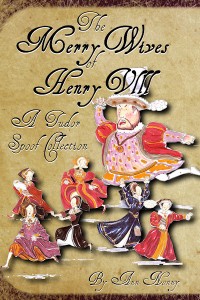 I’m excited to announce that Tim and I will soon be publishing a Tudor spoof collection entitled “The Merry Wives of Henry VIII”.
I’m excited to announce that Tim and I will soon be publishing a Tudor spoof collection entitled “The Merry Wives of Henry VIII”.
I’ve published a few anonymous spoofs here on The Anne Boleyn Files and they have always been warmly received and many of you have commented or written to me asking if they could be published. Well, I do listen to you and I did manage to persuade (finally!) the author to publish them and over thirty others as a book.
The author wants to remain anonymous – and before you ask, it isn’t me, I promise – so the book is being published under the name of Ann Nonny, get it?!
The book is all ready to go, we’re just waiting for the final illustrations from the artist and then it will be published, so it’s coming very soon. I hope this cover image, blurb and author bio will give you a taster.
Book Blurb
A collection of irreverent, tongue-in-cheek, side-splittingly funny Tudor history spoofs from the insane, but rather clever, Ann Nonny.
For the first time since the 16th century, we are able to share over 40 celebrated spoofs by Tudor literary genius (read mad woman) Ann Nonny. Her writing provides us with a unique insight into Tudor England, and the soap opera which was Henry VIII’s life.
Nonny’s work will no doubt find its way into the annals of English history and be enjoyed for many centuries to come.
Tales in this book include:
- 20 Things to Remember When Marrying Henry VIII
- The Second Boleyn Tart
- Bring Out Your Dead
- The Six Ex-Wives of Henry
- If Only There Had Been a Prenup
… and many more.
We would like to warn you not to drink coffee or any other beverage while reading this book.
This book is definitely not for children…
Author Bio – Ann Nonny
Ann Nonny was born in a hovel in the year c1520, her maiden name is not known. She married Non Nonny in 1534 and they had a total of 36 children. Some of her descendants gained high public office in the twentieth and twenty-first centuries, including a couple of previous English Prime Ministers and a famous Mayor of London.
Ann’s writings, which are contained here, were found by chance when sniffer dogs were searching the west bank of the Thames in the late 1800s. It took over one-hundred years to decipher her mad and often incoherent ramblings, but here they are!
We think Ann started her literary career at the time of Anne Boleyn’s execution in 1536, but that is only a guess based on the amount of blood stains found on the manuscript. Her writing provides us with a unique insight into Tudor England, which will no doubt find their way into the annals of English history.
We celebrate Ann’s remarkable work in this volume of her manuscripts.
Postscript: Ann died in a mad house in 1570. A sad end to an incredible life.